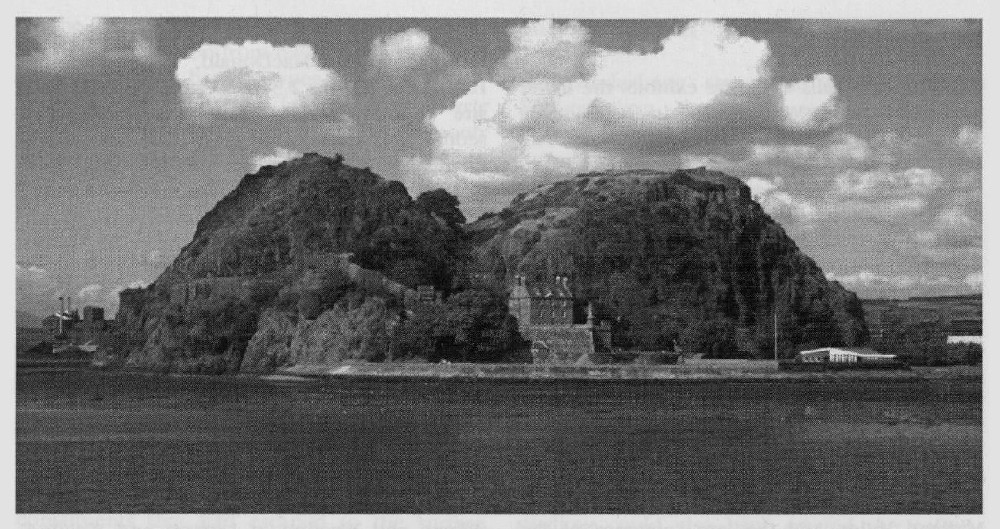Dumbarton Rock, West Dunbartonshire
J.G. MacDonald
Introduction
The prominent landmark of Dumbarton Rock, on the north bank of the River Clyde at its confluence with the River Leven, has been a fortified site since the 5th century AD or earlier. Its situation, visual impact and state of preservation make it particularly significant as an example of a volcanic plug. It is the westernmost of a series of basaltic plugs and necks, extending in a broad belt for more than 25 km in an ENE direction as far as the Campsie Fells, that define the Dumbarton–Fintry volcanotectonic line (Whyte and MacDonald, 1974; Craig and Hall, 1975;
Despite its easy accessibility, the excellent exposures of fresh glacially smoothed rock and the well-exposed relationships of the intrusive basalt with adjacent tuffs, agglomerate and sandstone, very little was published on Dumbarton Rock prior to a detailed investigation by Whyte (1966). Its popularity as a geological excursion locality is reflected by descriptions in field guides, based largely upon Whyte's account (Whyte and Weedon in Lawson and Weedon, 1992). Further geochemical aspects were discussed by Whyte (1980) and a single K-Ar whole-rock age determination of 302 ± 8 Ma (c. 308 Ma using new constants) was reported by De Souza (1979).
Description
Dumbarton Rock rises to a height of 73 m above the reclaimed intertidal mudflats at the mouth of the River Leven
The relationship between the intrusive basalt, adjacent pyroclastic rocks and associated sedimentary rocks is seen only on the north-west side of the plug
There is a narrow zone of contact alteration, up to 15 cm wide, in the sandstones and 'cementstones' adjacent to the plug, and sandstone xenoliths up to about 30 cm in diameter have been incorporated in the basalt. In the xenoliths, quartz may have been altered to tridymite in reaction rims. The basalt close to the contact is chilled and highly altered. The groundmass olivine and augite are completely altered to chlorite and the feldspar to albite; abundant amygdales are also present, containing spherulitic green chlorite and in some cases a little calcite. Chemical analyses indicate the incorporation of a significant amount of water into the basalt at, or closely following, the time of intrusion. This effect decreases away from the contact and is hardly discernible a metre or so into the plug. Within this 1 m zone, barium and strontium decrease in concentration towards the margin of the basalt and there is a corresponding increase in concentration of barium and, to a lesser extent, strontium in the immediately adjacent sedimentary rocks, especially in sandstone (Whyte, 1980).
Away from the contact zone the basalt of the plug is fine grained and has a uniform micro-porphyritic texture with microphenocrysts of labradoritic plagioclase and olivine (Fa31) set in a fine-grained groundmass of plagioclase, generally granular augite and opaque iron oxides. Accessory minerals include chlorite, analcime and apatite. In addition to the xenoliths of country rock incorporated in the margins, a few dunitic xenoliths have been found. Although no mineral layering has been detected, flow texture of microphenocrysts and groundmass feldspar laths is common. There is an apparent increase in the ratio of plagioclase to augite from an average of 2.3:1 at the base of the rock to 4.2:1 at the summit. Such variations in mode are common within lavas and plugs of basaltic affinity in the
Compositions of fresh basalts from Dumbarton Rock (Whyte, 1966, table 2) are similar in most respects to those found in lavas and plugs of Visean age in the nearby Kilpatrick Hills. The magnesium content, although unusually low, is within the range of variation found within the
Interpretation
It has commonly been assumed that Dumbarton Rock was emplaced as a vent intrusion at or near the top of the conduit of a volcano that was active during the time of eruption of the lavas of the Kilpatrick Hills (Whyte, 1966). However, whereas the northern outcrops of the
The joint pattern of Dumbarton Rock is consistent with the base of the cooling body of intruded basalt liquid having the form of an inverted cone. Hence Whyte (1966) deduced that the form of the base of the intrusion could have been determined by the shape of the volcanic crater into which it was emplaced. The basalt of the plug contains abundant amygdales in the contact zone but these become much less common away from the contacts. The presence of amygdales is a clear indication that the basalt was emplaced at low pressure and most likely at a time when there was a connection with the surface. From this it can be inferred that the plug infilled the vent of an active volcano and might indeed represent the lower part of a lava lake that formed in the active crater. Lava lakes formed in such conditions can remain liquid for sufficient time to allow degassing to take place; hence the paucity of amygdales in all but the chilled margins of the plug. The degassing of the magma could account for the freshness of the olivine, which in Visean volcanic rocks is almost invariably replaced by secondary minerals. Mineralogical and geochemical evidence also suggests the subsequent outward migration of volatiles, resulting in chloritization, albitization and some leaching of trace elements from the basalt into the immediately adjacent country rock (Whyte, 1980).
The marginal ring of pyroclastic rocks contains tilted blocks of the
Conclusions
The Dumbarton Rock GCR site combines historical significance as a fortified site with geological importance as the remnant of a mass of lava that solidified in the crater of an Early Carboniferous volcano. It is composed of alkali olivine basalt and has close petrographical and geochemical affinities with the Visean volcanic rocks of the




